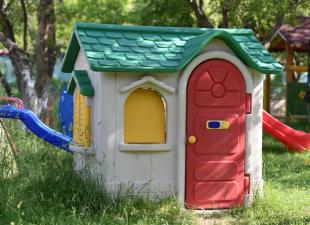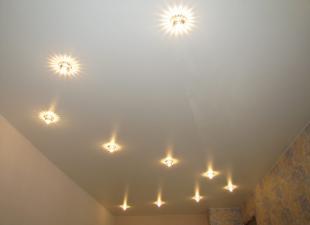Hello, dear visitors of the “Needleworker” website! Today we are opening a new column dedicated to interior design. And the first article will be about lighting. You will learn how important it is to find the right light for every room in your home. In addition, we will tell you about the different types of lamps. Our team hopes you find it interesting!
We need light in the same way as air, water, food and heat. Sunlight has a beneficial effect on the body: it increases immunity, stimulates the nervous system, and improves mood.
Lighting is responsible for the visual perception of the interior. The most modest bedroom decor seems homely warm when you turn on the sconce. It is pleasant to relax in the living room when soft diffused light streams through the lampshade of the floor lamp. If you illuminate the bedroom with bright fluorescent lamps, then it will resemble a museum. By replacing the fabric lampshade in the living room with a blue glass bulb, you can get special effects for a fantastic movie. The same colors, shapes and sizes of objects are perceived differently under different lighting conditions.
Good light is able to visually expand the space, while its lack, on the contrary, “shifts” the walls.
Household lighting consists of two types of light:
- natural - its quantity depends on the following factors: the geographical latitude of the area, time of day, atmospheric transparency, cloudiness, the number and size of windows, their location relative to the cardinal points, etc.
- artificial - created by lighting fixtures. It should be uniform and comfortable, not too dim, but not very bright either.
Depending on the location, the light can be:
- common- lighting of the entire room or most of it;
- local- distributed in a certain area of the room. This is used to highlight functional areas in the interior: work, dining, etc.
According to the direction of the flow, the lighting is divided into:
- scattered- creates a soft, relaxing light that dissolves in space;
- directed- is a concentrated, isolated bundle.
Types of lamps

The main part of the lighting fixture is the lamp. The principle of its operation is simple: an electric current is converted into light energy. In everyday life they use incandescent, halogen and fluorescent lamps.
Incandescent lamp- a sealed glass flask filled with an inert gas. In its lower part there is a threaded metal plinth. It allows the lamp to be screwed into the luminaire.
Pros:
- low cost compared to other types of lamps;
- low cost of lamps for them;
- ubiquity
Minuses:
- low efficiency;
- short term of work;
- high power consumption;
- small light output;
- great heat transfer
Halogen lamp- a tube made of refractory glass filled with an inert gas with the addition of halogens. Halogens reduce filament evaporation and thereby increase filament temperature, brightness and service life. At one end of the tube there is a base with "antennae", with their help the lamp is attached to the socket.
Pros:
- high efficiency (a 35 W lamp gives the same amount of light as a 60 W incandescent lamp);
- long service life, about twice that of an incandescent lamp
Minuses:
- high price;
Fluorescent Lamp- a sealed cylinder with electrodes at the ends, in which a fluorescent gas with the addition of mercury is located under low pressure. The inner surface of the flask is covered with a layer of a luminous substance - a phosphor.
Pros:
- the lamp creates soft lighting that is comfortable for the eyes;
- lasts up to five times longer than an incandescent lamp;
- consumes little electricity (an 11 W fluorescent lamp gives the same amount of light as a 60 W incandescent lamp)
Minuses:
- sensitivity to humidity, sudden temperature fluctuations and power surges;
high price; - high cost of the corresponding lamps
Now we are smoothly moving on to how to build the right lighting for different rooms. We will conditionally divide the rooms in the house into two groups:
- Residential: living room, bedroom, nursery, study;
- Household: dining room, kitchen, hallway, bathroom.
Living spaces
Living room

It is customary to distinguish several functional areas in the living room:
- recreation area
- entertainment area
- guest area
Lighting plays an important role in the zoning of the room. It consists of three types:
- common- depends on the size of the room and the number of functional areas. If the area is small, then one chandelier in the center of the ceiling will be enough. In a spacious living room, the general light must be duplicated. It is important to determine which zone will be the main one. Lighting design should be based on that most frequently used part of the room. If this is a seating area, then the focus of the lighting shifts to the sofa and TV.
- local- serves to highlight zones or specific objects in the interior. The seating area usually contains a sofa, armchairs and a coffee table. The lighting here should be soft, comfortable for the eyes, but bright enough to, say, read. For these purposes, table lamps, floor lamps and sconces are perfect.
In the entertainment area where the TV is located, soft and diffused light is also needed. Instead of a floor lamp, you can use low-power spotlights. - decorative- used to illuminate spectacular objects: an aquarium, shelves with books or dishes, paintings, sculptures or beautiful plants. The light can be made colored and even blinking, but only if it will be appropriate to look in the given interior.
Bedroom

The bedroom is a relaxation room, so it needs cozy and relaxing lighting.
- general light- soft, no glare. It can be created using lighting fixtures with domed fabric shades and frosted glass shades. For a small room, one chandelier will be enough. In a spacious bedroom, you will need additional light sources: floor lamps, sconces, high table lamps.
- local lighting created using a classic night light or sconce. If the presence of bedside tables is provided, then each of them should have a night light. If the berth is located against the wall, it will be wiser to hang a sconce over the headboard or put a floor lamp next to it.
- decorative lighting - point lighting devices. It is better to avoid “cold” light in the bedroom - it will disturb the atmosphere of intimacy. Lamps with shades of soft colors (yellow, brown, pink) will be very useful.
Children

In the children's room, the child plays, sleeps, does homework, reads, and is engaged in creativity. So that the baby's eyes do not get tired, you need to create a comfortable and maximally adapted lighting for various purposes.
- general light- absent-minded. It will be provided by a chandelier with a matte or fabric coating, located in the center of the ceiling. Plafonds made of crystal and openwork glass should not be used, as they create glare, and the light from them is harsh.
- local lighting needed in two places: at the desk and at the head of the bed. For the table, a table lamp, which is called a school lamp, is suitable. Instead, it is permissible to use a lamp with a white, beige, milk or cream shade. Above the bed, you can hang a sconce or install a night light. If the child is still small, then a night light with adjustable light intensity is perfect. Bright light is harmful to babies, so the lighting of the bed should be soft. For older children, a clothespin with a halogen lamp can be placed at the head of the bed. Particular attention should be paid to the computer lighting: the light should be soft, not creating glare on the monitor.
- decorative light in a children's room it is rarely used, since a directed and contrasting light flux is contraindicated for the vision of young children. If you nevertheless decide to arrange decorative lighting in the nursery, then it is better to use fluorescent lamps or low-power halogen lamps.
Cabinet

An office is a room for work. Concentration of attention can be achieved only if the workplace is comfortable not only physically, but also psychologically. Lighting plays an important role in this.
- general light- uniform, diffused, soft. These requirements are met by a chandelier with a matte shade made of light glass. In a spacious office, it is advisable to duplicate the overhead light, for example, with spotlights along the perimeter of the ceiling. When the general lighting is not enough, it can be enhanced with sconces or lamps, the light of which is directed towards the ceiling.
- local lighting: if the work is connected with a computer, then you need to exclude glare on the monitor. For this, two wall lamps and a table lamp “blocking” reflections on shiny surfaces are used. It is better to read with a table lamp with a lampshade made of frosted glass or fabric in warm shades.
- decorative lighting - must be adjustable with the ability to change the intensity of the luminous flux. It is undesirable to use colored light, it distracts attention. Sources of decorative light must be placed away from the desktop and made not too bright, otherwise they will interfere with peripheral vision.
Service premises
Canteen

The dining room should have a comfortable and relaxing atmosphere for socializing.
- general light- one or two chandeliers and several local sources, depending on the size of the room. The main chandelier must be placed directly above the table, as it is the most significant piece of furniture. In the event that the dining group is displaced from the central part of the room, then the chandelier should also be moved. If it is far from the center of the dining room, then you will need an additional lamp, located symmetrically. A good option is a chandelier with an adjustable height, which can be lowered to create a warmer atmosphere or raised higher, making the atmosphere solemn. Halogen spotlights above the desk are best avoided as they look “office-like” and create harsh light.
- local lighting depends on the style in which the room is made: for the classic style, sconces symmetrically hung on the walls are suitable; in a modern room, spotlights along the contour of the ceiling, covered with frosted glass, are appropriate.
- decorative lighting used extremely rarely. When using such lighting, it is important not to overdo it, so as not to disturb the atmosphere of comfort and tranquility. Soft, unobtrusive directional light of warm shades, emphasizing a beautiful panel or an exotic plant, will add charm to the dining room.
Kitchen

Any kitchen, regardless of size, has two zones: work and lunch... They are illuminated in different ways.
- general light: for a small kitchen, one chandelier with two or three shades is enough. They will provide bright, even lighting. In a spacious room, lighting will have to be created using several sources: the main chandelier and lamps located around the perimeter... If the dining area is clearly defined in the kitchen, then you will need a separate chandelier above the table.
- local lighting: the working area is the basis of the kitchen. It should have bright but soft lighting. Fluorescent lamps along wall cabinets work well.
Hallway

The hallway is the border between the outside world and private life. The lighting of this part of the apartment is influenced by the layout. If the hallway is not separated from the living area, then moving from the room to the kitchen, we pass through it. In this case, an orientation light is required, which burns around the clock, which increases the consumption of electricity. In this situation, it is logical to use lamps with motion sensors: when someone enters the hallway, the light will turn on automatically and turn off when the person leaves the area of the sensors.
- general light- provided by a ceiling chandelier. A single-lamp luminaire with a matte shade or fabric shade is suitable for a small room.
- local lighting organized either with a lack of general light, or for the convenience of the owners. In a spacious hallway for additional lighting, spotlights are allowed along the central axis or the perimeter of the ceiling.
Bathroom
 The bathroom room should be almost the brightest place, here people take care of the face and body, and this requires a bright and even light.
The bathroom room should be almost the brightest place, here people take care of the face and body, and this requires a bright and even light.
- general light- depends on the size of the room. A small room can be illuminated by a chandelier with a matte shade or a lamp above the sink. In a spacious bathroom, multi-position lighting is used - additional lamps are placed at important points: near a mirror, cabinet, bath or shower. In a room with high ceilings, it is better to use reflected light, which is created by a lamp with a mirror or metal reflector.
- local lighting applied over the sink and adjacent mirror. A good option is symmetrical lamps with matte shades on both sides of the mirror.
- decorative lighting rarely used. Chromotherapy (treatment with colored light) is gaining popularity. To create this effect, you can send beams of light from halogen lamps to the bath, and keep the rest of the room in the twilight.
We have told you about the types of lighting lamps, how to choose harmonious lighting for each room in the house, and we hope that our tips will be useful to you. Follow our updates and you will learn even more about interior design.
Interior design - part 1. How to choose the right lighting for rooms in the house
 parlini.ru Repair of an apartment, a summer residence and a house.
parlini.ru Repair of an apartment, a summer residence and a house.


